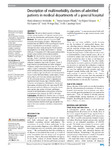Mostrar o rexistro simple do ítem
Description of multimorbidity clusters of admitted patients in medical departments of a general hospital
| dc.contributor.author | Matesanz Fernández, María | |
| dc.contributor.author | Seoane-Pillado, Teresa | |
| dc.contributor.author | Iñiguez-Vázquez, Iria | |
| dc.contributor.author | Suárez-Gil, Roi | |
| dc.contributor.author | Pértega-Díaz, Sonia | |
| dc.contributor.author | Casariego Vales, Emilio | |
| dc.date.accessioned | 2022-05-18T10:19:56Z | |
| dc.date.available | 2022-05-18T10:19:56Z | |
| dc.date.issued | 2021-02-05 | |
| dc.identifier.citation | Matesanz-Fernández M, Seoane-Pillado T, Iñiguez-Vázquez I, Suárez-Gil R, Pértega-Díaz S, Casariego-Vales E. Description of multimorbidity clusters of admitted patients in medical departments of a general hospital. Postgrad Med J. 2022;98(1158):294-299 | es_ES |
| dc.identifier.issn | 0032-5473 | |
| dc.identifier.uri | http://hdl.handle.net/2183/30685 | |
| dc.description | Review | es_ES |
| dc.description.abstract | [Abstract] Objective: We aim to identify patterns of disease clusters among inpatients of a general hospital and to describe the characteristics and evolution of each group. Methods: We used two data sets from the CMBD (Conjunto mínimo básico de datos - Minimum Basic Hospital Data Set (MBDS)) of the Lucus Augusti Hospital (Spain), hospitalisations and patients, realising a retrospective cohort study among the 74 220 patients discharged from the Medic Area between 01 January 2000 and 31 December 2015. We created multimorbidity clusters using multiple correspondence analysis. Results: We identified five clusters for both gender and age. Cluster 1: alcoholic liver disease, alcoholic dependency syndrome, lung and digestive tract malignant neoplasms (age under 50 years). Cluster 2: large intestine, prostate, breast and other malignant neoplasms, lymphoma and myeloma (age over 70, mostly males). Cluster 3: malnutrition, Parkinson disease and other mobility disorders, dementia and other mental health conditions (age over 80 years and mostly women). Cluster 4: atrial fibrillation/flutter, cardiac failure, chronic kidney failure and heart valve disease (age between 70-80 and mostly women). Cluster 5: hypertension/hypertensive heart disease, type 2 diabetes mellitus, ischaemic cardiomyopathy, dyslipidaemia, obesity and sleep apnea, including mostly men (age range 60-80). We assessed significant differences among the clusters when gender, age, number of chronic pathologies, number of rehospitalisations and mortality during the hospitalisation were assessed (p<0001 in all cases). Conclusions: We identify for the first time in a hospital environment five clusters of disease combinations among the inpatients. These clusters contain several high-incidence diseases related to both age and gender that express their own evolution and clinical characteristics over time. | es_ES |
| dc.language.iso | eng | es_ES |
| dc.publisher | BMJ | es_ES |
| dc.relation.uri | http://dx.doi.org/10.1136/postgradmedj-2020-139361 | es_ES |
| dc.rights | Atribución-NoComercial-SinDerivadas 3.0 España | es_ES |
| dc.rights.uri | http://creativecommons.org/licenses/by-nc-nd/3.0/es/ | * |
| dc.subject | General medicine | es_ES |
| dc.subject | Health policy | es_ES |
| dc.subject | Internal medicine | es_ES |
| dc.title | Description of multimorbidity clusters of admitted patients in medical departments of a general hospital | es_ES |
| dc.type | info:eu-repo/semantics/article | es_ES |
| dc.rights.access | info:eu-repo/semantics/openAccess | es_ES |
| UDC.journalTitle | Postgraduate Medical Journal | es_ES |
| UDC.volume | 98 | es_ES |
| UDC.issue | 1158 | es_ES |
| UDC.startPage | 294 | es_ES |
| UDC.endPage | 299 | es_ES |
Ficheiros no ítem
Este ítem aparece na(s) seguinte(s) colección(s)
-
GI-GIRS - Artigos [89]






